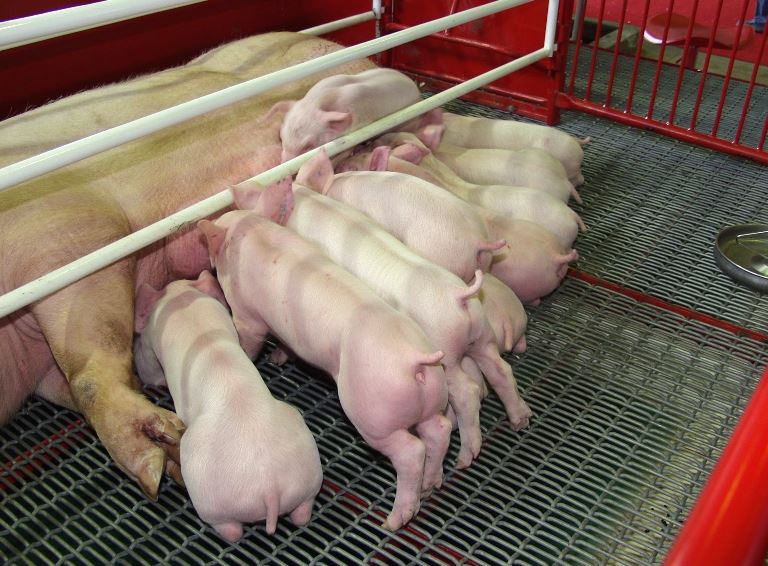
At the end of this week, the USDA will publish the results of their March hog inventory survey. Most of the attention will fall, as it should, on the inventory numbers. How many hogs the country has is what matters in the short run. USDA’s Hogs and Pigs reports have done a very good job in recent quarters of getting the market hog inventory right. Hog slaughter this winter was within 0.3% of the number implied by the Dec. 1 market hog inventory. Hopefully, their outstanding performance will extend to this month’s report.
In the long run, what matters more than the inventory numbers are productivity numbers — pigs per litter and the pounds of pork per sow. It is the productivity of the nation’s hog farms that determines whether pork is competitive with other meats in the domestic market and whether U.S. pork production is competitive with foreign pork on the world market.
In 1930, U.S. hog farms averaged 878 pounds of carcass weight pork produced per sow. Last year, the United States produced an average of 4,200 pounds of pork per sow. That is an average annual increase of a bit more than 1.9% per year for the last 85 years.
The United States is the world’s largest pork exporter. Last year, we exported 20.2% of U.S. pork production while pork imports equaled only 4.5% of production. Last year, the U.S. produced more pork than beef for the first time since 1952. We are likely to do so again this year. These accomplishments are possible because of the productivity of U.S. hog farms.
In 1930, the nation averaged 7.69 pigs per sow per year. We didn’t reach a 10 pig average until 1954. The U.S. average has been above 20 pigs per sow per year every year since 2008. This is far from outstanding. Pigs per sow must continue to increase for U.S. pork to remain cost competitive.
The two components of increased pork production per sow are more pigs per sow and heavier slaughter weights. The breeding herd utilization rate (litters per sow per year) has held fairly steady for the last decade. Most of the improvement in pigs per sow per year has come from larger litter size.
Pigs per litter were above the year-ago level each quarter from the fall of 2003 through the fall of 2013. Over this 10-year stretch, the average increase in pigs per litter was 1.4% per year. Then porcine epidemic diarrhea struck and pigs per litter dropped by more than 5% in the winter and spring of 2014. But, producers have recovered. The last three quarters have set records for pigs per litter at 10.37, 10.39 and 10.53 pigs per litter, respectively. Will we get a new record in Friday’s USDA report? Probably not, since pigs per litter are usually lower in the winter than in other seasons.
Built for weight
Enhanced genetics have allowed producers to steadily increase slaughter weights. Over the last 60 years, the average carcass weight for hogs has increased by 77 pounds. Record hog prices in 2014 led to a 6.8 pound year-over-year increase in the average hog carcass weight. That was the biggest annual increase in hog weights since World War II. Hog prices dropped 33% in 2015 and carcass weights were down 1.5 pounds from the year before. It currently looks like 2016 weights will average a bit lighter than last year.
Each year there are more Americans to feed and more foreign customers looking for meat. Over the last 85 years, U.S. hog slaughter has increased by an average of 0.9% per year. Because of increased slaughter weights, pork production has grown even faster — an average of 1.5% per year. But, that hasn’t meant a larger sow herd. Because of more pigs per sow per year, the sow herd has decreased at an average rate of 0.7% per year.
Increased productivity means more pork, fewer sows. The U.S. sow herd is nearly 40% smaller than in 1930.
Growth industry
U.S. pork production is a growth industry. For consumers it provides an average of 1.5% more pork each year to feed the world’s growing population. For hog packers it provides roughly a million more hogs to process each year (with a lot of year-to-year variation in slaughter numbers). This means packers need to add to slaughter capacity over time. Two big new hog plants are scheduled to open in 2017 and give slaughter capacity a big boost. For hog farmers, enhanced productivity is a lot of hard work, but it is the price that must be paid to remain competitive.
About the Author(s)
You May Also Like





